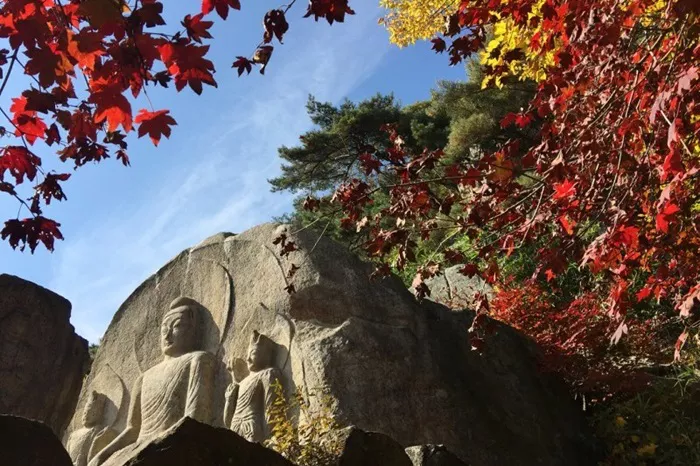There are several large and small Buddhist temples in South Korea that have very successful “Templestay” programs.
These programs usually arrange a series of activities where participants can participate in various Buddhist activities, such as visiting temples, drinking tea with monks or nuns, practicing meditation, or making lotus lanterns.
However, when we set out on a journey through Namsan Mountain in Gyeongju City, Gyeongsangbuk-do, we unexpectedly enjoyed a temporary stay in a nunnery.
We started from Samneung Valley, crossed the top of the mountain, entered Yaksu Valley, passed through the ruins of Yongjangsa Temple, and finally arrived at our destination, Chilbolam.
This nunnery was set up to allow us to rest and relax after a seven-kilometer hike. I have never been so happy to see a temple or nunnery in my life.
Chilbolam means “Seven Buddhas” in English. It is located on the southeast slope of Namsan Mountain (495.1 meters). Gyeongju was once known as Seorabeul and was the capital of Silla (57 BC-935 AD). However, the modern form of the temple dates only to around the 1930s.
A local woman found the rock carvings of Buddha statues while digging in the dirt and bushes while searching for wild mushrooms and vegetables on this hill.
With the decline of Buddhism during the Joseon Dynasty from 1392 to 1910, the statues and reliefs in the temple were deliberately hidden. After their rediscovery, a nun built a hut on the grounds.
In 2009, the current main hall of Chilbongam was built. In the same year, the rock carvings were designated as a national treasure.
As the name suggests, the seven Buddha statues appear on two separate stones. Four of the Buddha statues appear on the smaller stone, which is located in front of the larger stone wall at the back. The larger stone has another three Buddha statues.
The larger stone is 2.7 meters tall and appears to have a statue of Amitabha (the Buddha of the Western Paradise) in the center. Amitabha sits on a lotus with a kind smile on his face. On the right is Avalokitesvara (Great Compassionate Bodhisattva), clearly visible with a nectar bottle in hand.
The last Buddha statue is presumed to be the Great Wisdom Bodhisattva (Amitabha Bodhisattva of Wisdom and Power). In front of the larger stone is a square stone with four Buddha statues on each side. This stone is called the “Four Square Buddhas” in English.
There is some controversy as to who each of these four Buddha statues represents. Also, from roof tiles found in the area, it is believed that these carvings were once housed in the shrine hall.
In addition to this amazing national treasure dating back to the early eighth century AD, which stands like a guardian on the top of the temple, there is also a stunning rock carving of a Bodhisattva. This 1.4-meter-tall relief overlooks the rock wall.
The statue shows a Bodhisattva wearing a large, ornate crown and a loose robe. The Bodhisattva sits upright on a pedestal with his left foot tucked under it.
The relief seems to be in a cloud of mist, and the Bodhisattva’s slightly open eyes look thoughtfully at Gyeongju. The relief is believed to have been created in the late eighth century.
In recent years, perhaps because Chilfoam has become so popular with mountaineers, a compact house has even been brought in by helicopter for those who want to stay overnight at Chilfoam.
As such, we were warmly received by a Singaporean nun named Yuansheng, who made Chilfoam her home.
After a short break, we toured the hermitage. After a short break, we were welcomed into the temple by the nun for tea. We had a great chat about Buddhism, meditation, and Gyeongju.
After the talk, I was pleasantly surprised to receive one-on-one instruction on how to properly meditate in front of the stone carvings. After the session, I heard cheers of “Go!” from above the Bodhisattva statue on the mountain, wishing me good luck with my meditation.
Afterwards, my friend and I joined the nun for a 30-minute meditation in the main hall, looking out over the pink blossoms of the cherry blossom tree in front of the hermitage.
After the meditation, we finally got to work. Since there was only one nun in the nunnery at the time, we helped to take care of the grounds.
We tidied the courtyard, tucked in mats for worship, and carefully cleaned the ash from the incense burners on the main altars in the main hall and Samseonggak.
After dinner, we had another round of tea and prepared for bed. As night fell, we were pleasantly surprised by the light that illuminated the national treasure. There was more to appreciate about the stone figures, and the shadows highlighted details that were difficult to see during the day.
From every angle and in every light, this eighth-century work was breathtaking. After a long day of fun, adventure, and wonder, I fell asleep in the newly built building for overnight hermits.
Of course, the formal temple homestay program is great for those who are just beginning to learn about Korean Buddhism. It also works for those who want a more regular experience.
However, for those who want to experience something a little different, it may be a good idea to go to the temple in person and see if you can stay overnight there. If this option sounds like a good fit, then the Seven Buddhas Temple might be the place for you.

